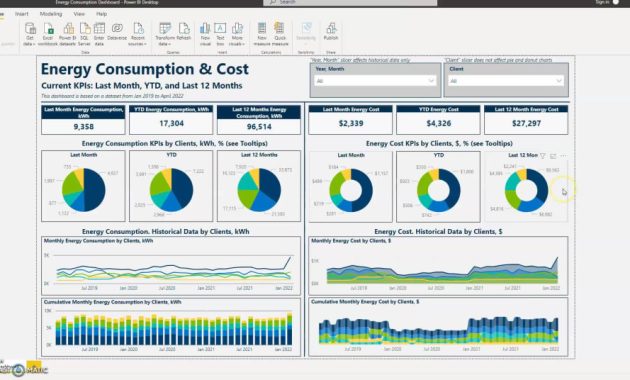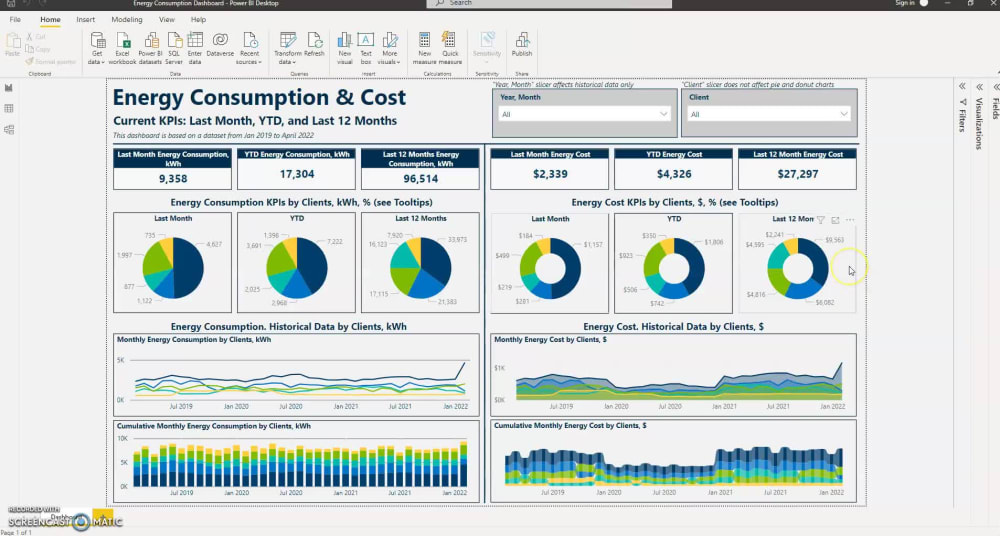
Why Energy Managers Use These BI Tools: Decoding Data for Efficiency
In the rapidly evolving landscape of energy management, the ability to make data-driven decisions is no longer a luxury, but a necessity. Energy managers are constantly seeking ways to optimize energy consumption, reduce costs, and improve sustainability. This is where Business Intelligence (BI) tools come into play. But why do energy managers consistently rely on these powerful tools? This article delves into the core reasons, highlighting the crucial role BI plays in the modern energy sector.
The primary goal of any energy manager is to improve efficiency and cut costs. BI tools offer a centralized platform for analyzing vast amounts of energy-related data. This data can come from various sources, including smart meters, building management systems (BMS), and weather data. By integrating these disparate data streams, energy managers gain a comprehensive view of their energy performance. This holistic perspective is invaluable for identifying inefficiencies and opportunities for improvement. The use of BI tools is now fundamental.
Unveiling the Power of Data Visualization
One of the key advantages of BI tools is their ability to transform raw data into easily understandable visual representations. Charts, graphs, and dashboards provide an intuitive way to monitor energy consumption patterns, identify anomalies, and track key performance indicators (KPIs). These visualizations empower energy managers to quickly grasp complex information, spot trends, and communicate findings to stakeholders effectively. A clear understanding of the data is critical. It helps to identify areas needing immediate attention.
Consider a scenario where a manufacturing plant experiences a sudden spike in energy usage during off-peak hours. Without a robust BI solution, detecting this anomaly might take weeks, resulting in significant energy waste and higher costs. With BI tools, the energy manager can quickly visualize the issue, pinpoint the source (e.g., a malfunctioning piece of equipment), and take immediate corrective action. This proactive approach is a hallmark of effective energy management.
Real-time Monitoring and Analysis
Real-time monitoring is another critical capability that makes BI tools indispensable for energy managers. These tools provide up-to-the-minute data on energy consumption, enabling managers to track performance against targets, identify deviations, and respond to fluctuations in real-time. This level of responsiveness is essential for optimizing energy usage and minimizing waste. Immediate action is often the most cost-effective solution.
For example, during periods of peak demand, energy managers can use BI tools to monitor energy usage and proactively adjust operations to reduce demand charges. This might involve temporarily shutting down non-essential equipment or shifting production schedules. The ability to make informed decisions in real-time can translate into substantial cost savings and improved energy efficiency.
Predictive Analytics and Forecasting
Beyond real-time monitoring, advanced BI tools offer predictive analytics capabilities. These tools leverage historical data and machine learning algorithms to forecast future energy consumption patterns. This allows energy managers to anticipate energy needs, optimize procurement strategies, and proactively manage energy costs. Predicting future needs is a valuable asset.
For instance, an energy manager can use predictive analytics to forecast energy demand based on factors such as weather patterns, production schedules, and occupancy levels. This information can be used to negotiate favorable energy contracts, schedule maintenance activities, and optimize energy usage across the organization. This proactive approach helps avoid unexpected costs.
Improved Reporting and Communication
Effective communication is essential for successful energy management. BI tools streamline the reporting process, allowing energy managers to generate comprehensive reports and dashboards that clearly communicate energy performance to stakeholders. These reports can be customized to meet the specific needs of different audiences, from executive management to operational staff. This process saves valuable time.
By providing clear, concise, and data-driven reports, energy managers can demonstrate the value of their efforts, secure funding for energy efficiency projects, and foster a culture of energy conservation throughout the organization. This also helps promote transparency. It ensures everyone is on the same page.
Cost Optimization and Savings
One of the most compelling reasons why energy managers use BI tools is the potential for significant cost optimization and savings. By providing insights into energy consumption patterns, identifying inefficiencies, and enabling proactive management, these tools empower energy managers to reduce energy costs and improve profitability. The financial benefits are substantial.
For example, by identifying and addressing energy waste, energy managers can reduce their energy bills, avoid penalties for exceeding demand limits, and qualify for rebates and incentives for energy efficiency projects. These savings can be reinvested in other areas of the business. This will ultimately improve the bottom line.
Compliance and Sustainability Goals
In addition to cost savings, BI tools play a crucial role in helping organizations meet their compliance and sustainability goals. As regulations regarding energy efficiency and carbon emissions become increasingly stringent, energy managers need tools that can track and report on their energy performance. Meeting these goals is now more important than ever.
BI tools can be used to monitor energy consumption, track carbon emissions, and generate reports that demonstrate compliance with regulatory requirements. This enables organizations to meet their sustainability targets, reduce their environmental impact, and enhance their reputation. Using BI tools helps achieve compliance. It also supports sustainability initiatives.
Integration with Other Systems
Modern BI tools are designed to integrate seamlessly with other systems commonly used in energy management, such as BMS, SCADA systems, and utility data platforms. This integration allows energy managers to consolidate data from various sources, gain a holistic view of their energy performance, and make more informed decisions. Integration enhances the overall efficiency.
For example, integrating a BI tool with a BMS allows energy managers to monitor and control building systems in real-time, optimizing energy usage and reducing waste. This integration creates a powerful ecosystem. This system is designed for effective energy management.
Key Features of BI Tools for Energy Managers
- Data Integration: Ability to connect to various data sources.
- Data Visualization: Interactive dashboards and charts.
- Real-time Monitoring: Immediate insights into energy consumption.
- Predictive Analytics: Forecasting future energy needs.
- Reporting and Analysis: Generating customized reports.
- Alerting and Notifications: Automated alerts for anomalies.
- Mobile Accessibility: Access data from anywhere.
- User-Friendly Interface: Easy to use and navigate.
Choosing the Right BI Tool
Selecting the right BI tool is crucial for maximizing its benefits. Energy managers should consider several factors when making their decision, including the tool’s features, scalability, integration capabilities, and cost. Also, consider the ease of use and the level of support provided by the vendor.
Conducting thorough research, evaluating different options, and seeking feedback from other energy professionals can help ensure that the chosen BI tool meets the organization’s specific needs and objectives. The right tool can make a big difference.
Future Trends in BI for Energy Management
The field of BI tools for energy management is constantly evolving. Several trends are shaping the future of this technology, including the increasing use of artificial intelligence (AI) and machine learning (ML), the growing adoption of cloud-based solutions, and the rise of the Internet of Things (IoT). The future looks promising.
AI and ML are being used to automate data analysis, identify patterns, and provide more accurate predictions. Cloud-based solutions offer greater scalability, flexibility, and cost-effectiveness. The IoT is expanding the availability of energy data. These trends will continue to drive innovation in the field of BI tools.
Conclusion: The Indispensable Role of BI Tools
In conclusion, BI tools have become an indispensable asset for energy managers. They provide the insights, analytics, and reporting capabilities needed to optimize energy consumption, reduce costs, and improve sustainability. By leveraging the power of data, energy managers can make informed decisions, proactively manage energy usage, and contribute to a more efficient and sustainable future. These tools are transforming the industry.
The adoption of BI tools is not just a technological upgrade. It’s a strategic shift towards data-driven decision-making. This shift empowers energy managers to become more effective. It also allows them to drive significant improvements in energy performance. The future of energy management is undeniably linked to the effective use of BI tools. [See also: Related Article Titles]

